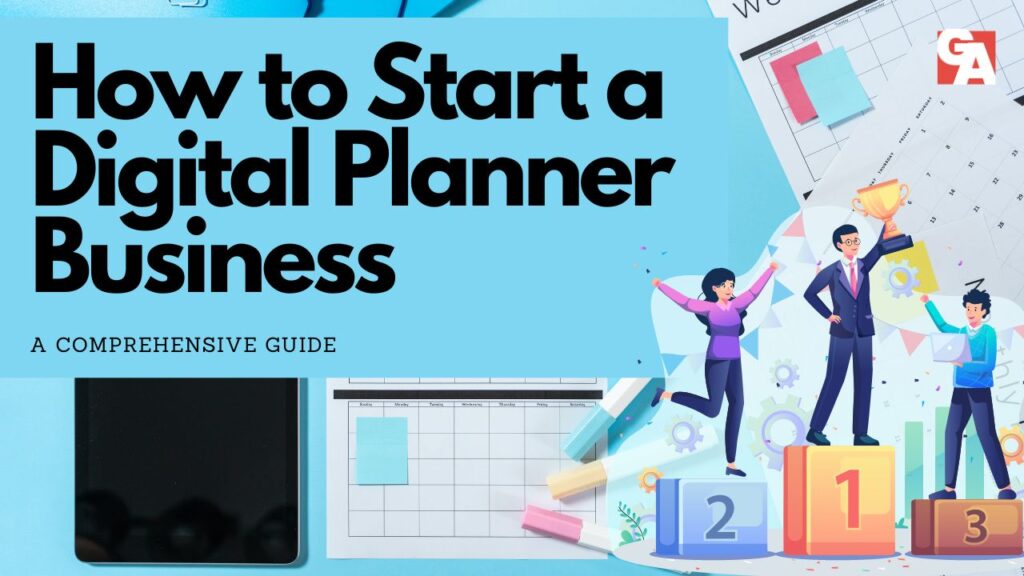In today’s digital age, the demand for digital planners is skyrocketing as more people seek efficient and flexible ways to organize their lives. Starting a digital planner business can be an exciting and profitable venture. This comprehensive guide will walk you through the essential steps to kickstart your own digital planner business, from market research to product development and marketing strategies. So let’s dive in!
What is Digital Planner Business?

A digital planner business refers to a company or entrepreneurial venture that focuses on creating, developing, and selling digital planners. A digital planner is a virtual or electronic version of a traditional paper planner or agenda. It is typically accessed and used through digital devices such as smartphones, tablets, or computers.
The digital planner business involves designing and offering digital planner templates or apps that users can customize and use to organize their schedules, tasks, goals, and other aspects of their lives. These digital planners often provide features such as interactive calendars, to-do lists, habit trackers, note-taking capabilities, and goal-setting tools. They offer the convenience of digital technology, allowing users to access and update their planners anytime, anywhere.
Digital planner businesses cater to individuals who prefer the flexibility, mobility, and eco-friendliness of digital planning solutions. They may target various market segments, such as professionals, students, busy parents, creative entrepreneurs, or individuals seeking efficient and organized ways to manage their personal and professional lives.
The digital planner business model can involve selling digital planners as standalone products, offering subscription-based access to a library of planner templates, or providing additional services such as customization, integration with other productivity tools, or digital planning workshops.
Successful digital planner businesses often focus on creating visually appealing, user-friendly designs, and incorporating features that meet the specific needs and preferences of their target audience. They employ effective branding, marketing, and customer support strategies to attract and retain customers in the competitive digital planning market.
Section 1: Market Research and Target Audience

Before launching your digital planner business, it’s crucial to conduct thorough market research. Understanding your target audience and their needs will help you tailor your products and marketing strategies effectively.
Identify Your Niche
To identify your niche, consider specific demographics or interests that your digital planners can cater to. For example, you could focus on digital planners for busy moms, professionals in specific industries like finance or healthcare, or planners designed for creative entrepreneurs. By narrowing down your niche, you can create products and marketing messages that resonate with your target audience.
Analyze the Market
Research your competitors and analyze their offerings, pricing, and marketing strategies. Look for gaps or areas where you can differentiate your digital planners.
For instance, if most competitors focus on minimalistic designs, you could offer a range of colorful and artistic planner templates. By analyzing the market, you can position your business uniquely and offer something valuable to your target audience.
Define Your Target Audience
Create buyer personas based on the demographics, preferences, and pain points of your ideal customers. For example, one persona could be a working professional in their late 20s, seeking a digital planner to balance work and personal life.
Understanding your target audience’s goals, challenges, and motivations will help you tailor your product features, designs, and marketing messages to meet their specific needs.
Section 2: Product Development

Developing a high-quality and user-friendly digital planner is the cornerstone of your business. This section will outline the key steps involved in creating a compelling digital planner product.
Choose a Platform
Consider the platform that best suits your digital planner business. For example, you could develop a standalone planner app for iOS and Android devices or create planner templates compatible with popular note-taking apps like GoodNotes or Notability.
Choose a platform that aligns with your target audience’s preferences and provides a seamless user experience.
Design Elements
Craft visually appealing and intuitive designs for your digital planners. Consider the layout, color schemes, and typography to create a cohesive and aesthetically pleasing user interface. For instance, you could offer different themes or styles such as minimalistic, floral, or bold designs to cater to diverse customer preferences. Focus on user experience by incorporating features like interactive calendars, to-do lists, habit trackers, and customizable templates.
Functionalities and Features
Think about the functionalities and features that will set your digital planner apart. For example, you could integrate features like reminders, goal tracking, note-taking capabilities, and integration with other digital tools such as Google Calendar or Trello. By providing unique and useful features, you can attract and retain customers.
Testing and Feedback
Once you have a prototype, gather feedback from potential customers or a focus group. Allow them to test your digital planner and provide input on its usability, functionality, and design. Iteratively refine your product based on their feedback, ensuring it meets their expectations and solves their pain points effectively.
Pricing Strategy
Determine a competitive yet profitable pricing strategy for your digital planners. Consider factors like production costs, perceived value, and competitor pricing.
For example, you could offer different pricing tiers such as basic, premium, or subscription models with additional features or access to exclusive content. Pricing experimentation and customer feedback can help you find the right balance between profitability and customer satisfaction.
Section 3: Branding and Marketing

To succeed in the competitive digital planner market, you must create a strong brand identity and implement effective marketing strategies. This section will guide you through the essential steps.
Brand Identity
Develop a compelling brand identity that resonates with your target audience. Choose a memorable name that reflects your brand’s values and personality. Create a visually appealing logo that captures the essence of your digital planner business.
Define your brand’s voice and tone, whether it’s friendly, professional, or creative. Consistency across all brand assets, including your website, social media profiles, and marketing materials, is crucial for building brand recognition and trust.
Website and Online Presence
Build a professional and user-friendly website to showcase your digital planners and provide a seamless purchasing experience. Optimize your website for search engines by incorporating relevant keywords in your website content, meta tags, and product descriptions.
For example, create dedicated landing pages for each planner category or offer blog content related to productivity and organization. A well-optimized website will improve visibility and organic traffic, helping your business rank higher in search engine results.
Content Marketing
Create valuable content that aligns with your target audience’s interests and pain points. For example, you could write blog posts, create video tutorials, or offer downloadable guides on topics such as time management tips, productivity hacks, or goal setting strategies.
Share this content on your website and social media platforms to attract and engage your target audience. Focus on providing value and establishing yourself as an authority in the digital planning space.
Social Media Marketing
Leverage popular social media platforms to promote your digital planners. Identify the platforms where your target audience is most active and create engaging content tailored to each platform.
For instance, you could share visual content and design inspiration on Instagram, create informative videos on YouTube, or engage in discussions and offer advice on relevant Facebook or LinkedIn groups. Collaborate with influencers or micro-influencers in your niche to expand your reach and tap into their dedicated follower base.
Email Marketing
Build an email list by offering freebies or exclusive content to your website visitors. Create lead magnets such as printable planner templates, productivity guides, or e-books that align with your target audience’s needs.
Use email marketing campaigns to nurture leads, provide valuable content, and promote new product launches or discounts. Personalization and segmentation can improve conversion rates. For example, segment your email list based on customer preferences or engagement levels to deliver targeted offers and recommendations.
Section 4: Operations and Growth

Running a digital planner business involves various operational aspects. This section will cover key considerations to ensure smooth operations and avenues for business growth.
Production and Distribution
Establish efficient workflows for the production and distribution of your digital planners. Determine whether you’ll offer digital-only planners or physical copies as well. If offering physical copies, consider partnering with printing or fulfillment companies to handle production and shipping. Automate processes where possible to streamline operations and reduce manual effort.
Customer Support
Provide exceptional customer support to build trust and loyalty. Offer multiple channels for customer inquiries, such as email, live chat, or social media. Respond promptly and professionally to address any concerns or issues.
Consider implementing a knowledge base or FAQ section on your website to provide self-help resources and reduce customer inquiries.
Continuous Improvement
Regularly gather customer feedback through surveys, reviews, or social media interactions. Track key performance metrics such as conversion rates, customer satisfaction, and customer retention.
Use this data to identify areas for improvement and innovation. Update and enhance your digital planners based on user suggestions and changing market trends. Stay up-to-date with technological advancements to offer innovative features that keep your business ahead of the competition.
Scaling and Expansion
Once your business gains traction, consider scaling and expanding your product offerings. Introduce new planner designs, collaborate with influencers or brands in complementary industries, or explore international markets.
Develop a strategic plan for growth, considering factors like production capacity, market demand, and resource allocation. Be adaptable to changing market dynamics and continuously seek opportunities for expansion.
Conclusion
Starting a digital planner business can be a rewarding journey if you approach it strategically. By conducting thorough market research, developing a compelling product, implementing effective marketing strategies, and focusing on operational excellence, you can position your business for success in the thriving digital planner market. Remember, perseverance and continuous innovation are key to thriving in this competitive industry. So, start planning your digital planner business today and make a mark in the world of digital organization!




